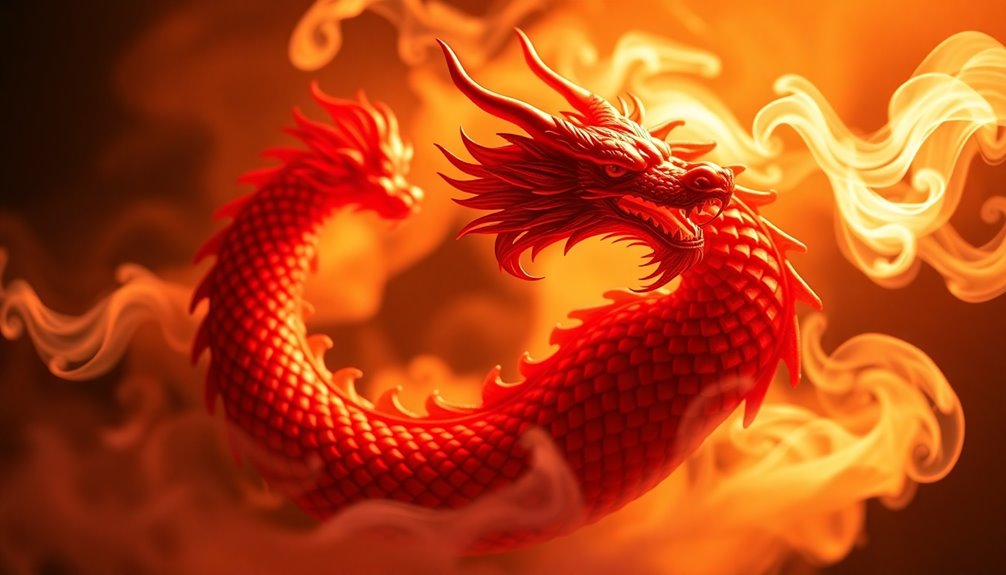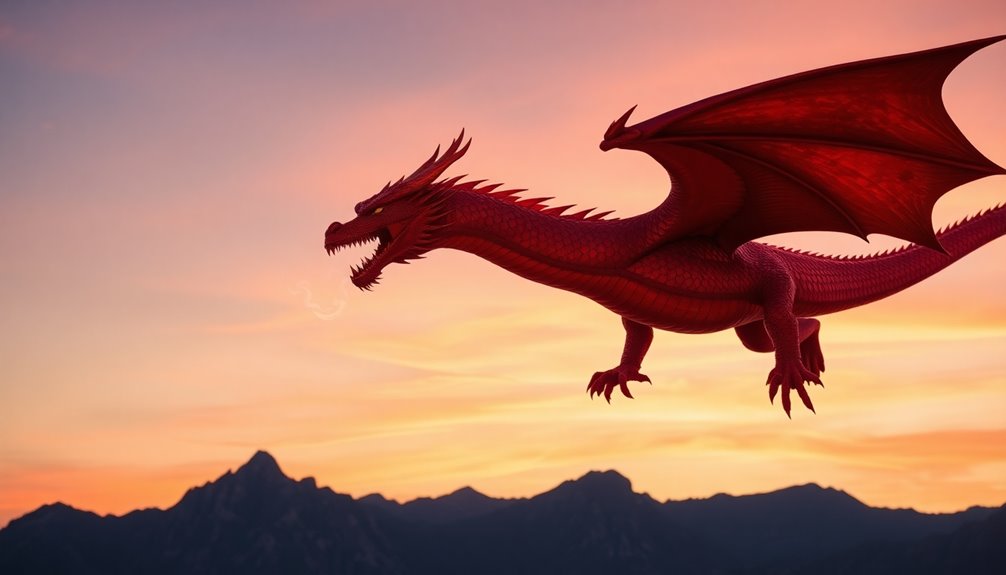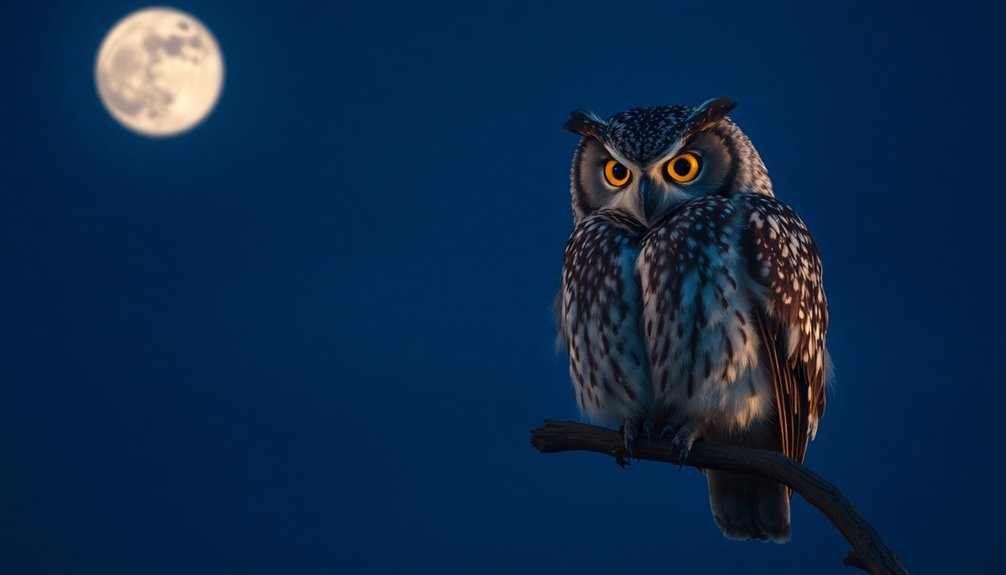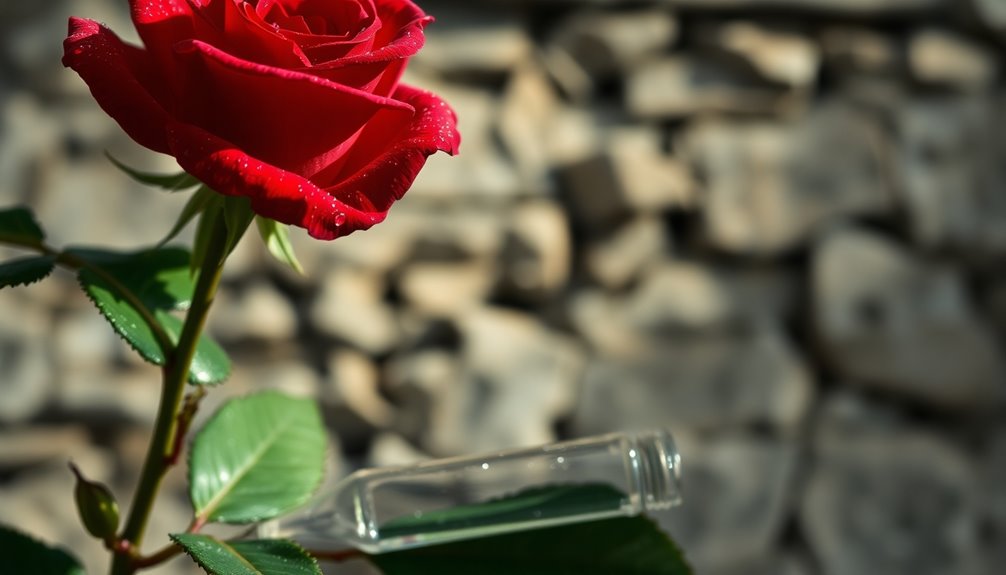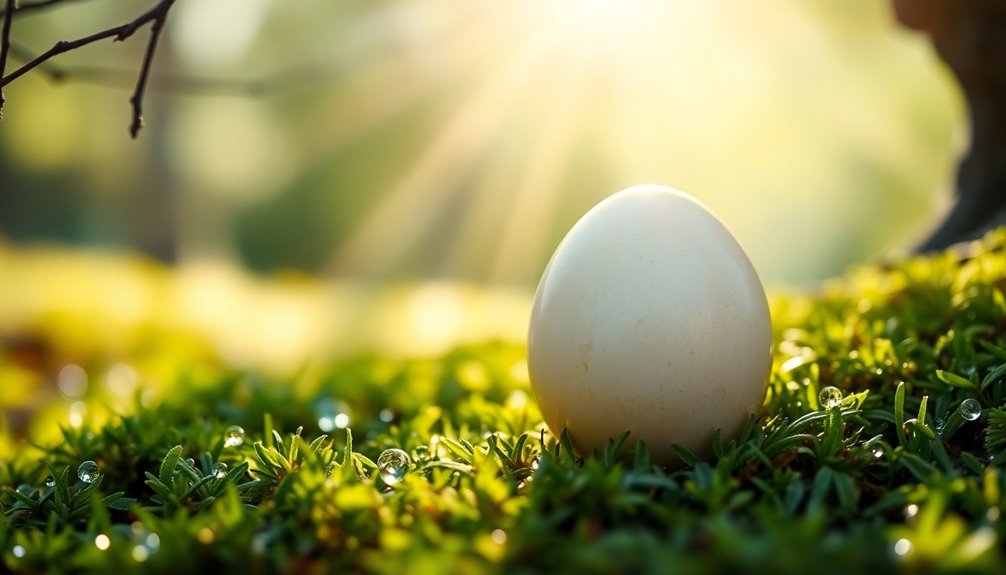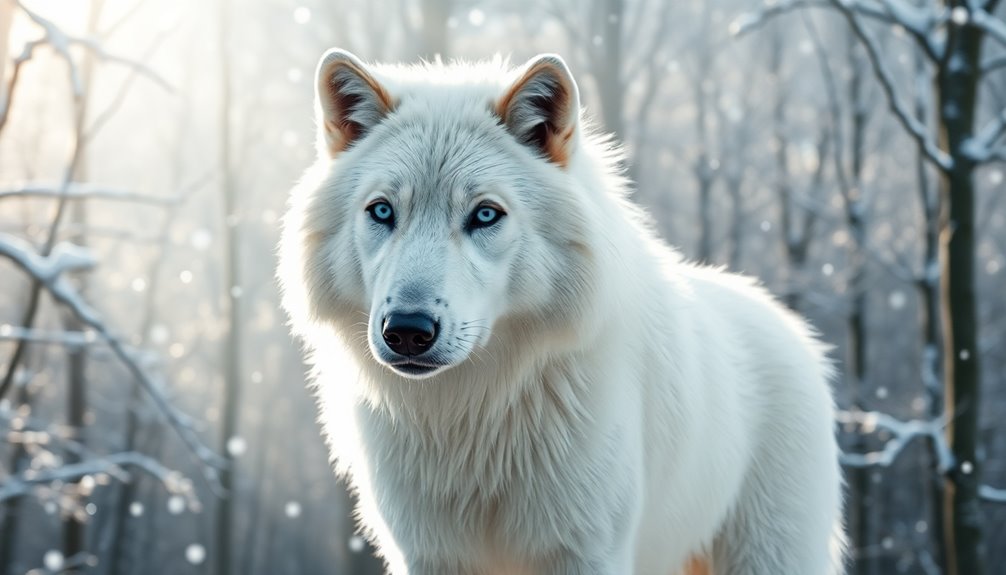The red dragon symbolizes power, transformation, and fortune across cultures. In Chinese mythology, it's revered as a bringer of good luck, embodying strength and healthy growth. You'll find it associated with celebrations like the Chinese New Year, where it represents joy and unity. In Celtic lore, the red dragon signifies protection and national identity. However, it also has darker representations in Western mythology, where it embodies chaos and destruction. With its fiery essence, the red dragon encourages personal transformation and mastery. You'll discover even more fascinating aspects of this captivating symbol as you explore further.
Key Takeaways
- The red dragon symbolizes power, authority, and good fortune, particularly in Chinese culture and during the Year of the Dragon.
- It represents transformation and renewal, reflecting personal metamorphosis and self-mastery across various cultural narratives.
- In Celtic mythology, red dragons signify national identity, protection, and the balance of elemental forces in nature.
- The red dragon's association with fire embodies strength and energy, highlighting its role as a fierce yet protective figure.
- Celebrations involving the red dragon, such as Chinese New Year, emphasize joy, prosperity, and the pursuit of harmony in life.
Symbolism in Chinese Culture
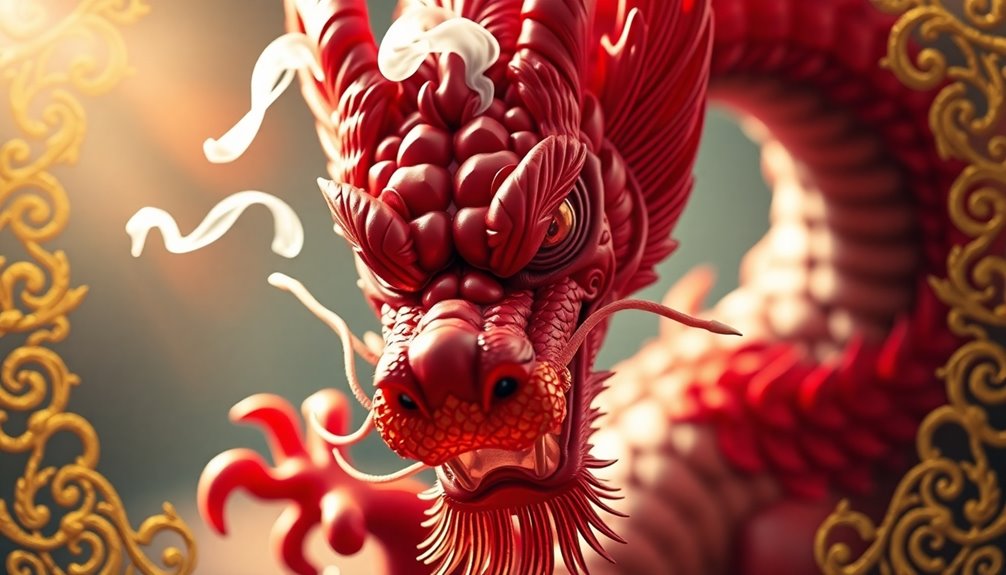
In Chinese culture, the red dragon symbolizes power, authority, and good fortune, making it a revered figure throughout history. You'll find that this majestic creature represents not only great strength but also control over natural elements like water, rainfall, and typhoons. The dragon is also celebrated in various Indigenous cultures, where it symbolizes cultural narratives that connect communities to their heritage and identity. Additionally, the dragon's ability to influence water attractions has made it a significant figure in various cultural celebrations. The dragon's powerful imagery aligns with its role in end-of-life care, where it symbolizes the journey of transformation and the acceptance of life's cycles.
Emperors and high officials proudly adopted the dragon as a symbol of their imperial power, believing they embodied this divine creature. In fact, only they were allowed to use dragon symbols, reinforcing its status as a mark of authority. The dragon's historical use as an imperial symbol during the Tang Dynasty further solidified its connection to royalty and governance. Similarly, the Hopi Tribe is recognized as guardians of sacred lands, which reflects the importance of cultural identity and heritage in different communities.
During Chinese New Year celebrations, the dragon takes center stage to usher in good luck and prosperity, representing the essence of Chinese civilization. Many people proudly identify as "Descendants of the Dragon," showcasing a deep connection to their heritage.
You might notice dragon motifs in traditional attire and on imperial flags, emphasizing its cultural significance.
Moreover, the dragon is often seen as a rain deity, fostering harmony and agricultural prosperity. By controlling the winds and rains, it's linked to bountiful harvests.
With its rich symbolism, the red dragon continues to embody the spirit and identity of the Chinese people, retaining its revered status across generations.
Mythological Significance
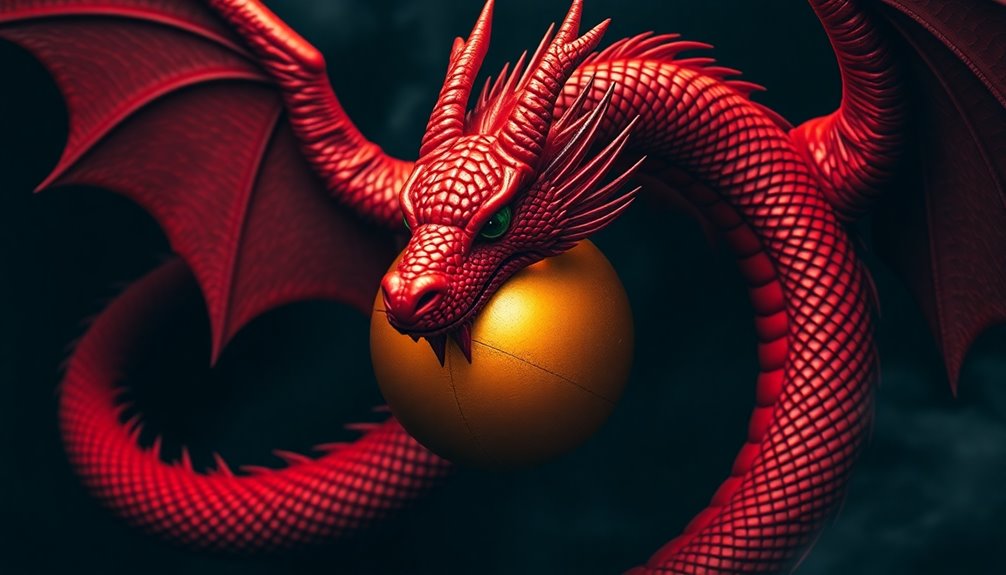
Red dragons hold a prominent place in mythologies worldwide, contrasting sharply with their revered status in Chinese culture. In Western mythology, you'll often encounter red dragons as fierce adversaries, embodying chaos and destruction. Tales like that of Saint George showcase them as ultimate foes, symbolizing bravery and skill in battle. These creatures frequently represent natural calamities, reflecting disorder and devastation in various folktales. The importance of celebrating relationships can be seen as a parallel to the connections formed between heroes and their adversaries in these tales.
In Celtic folklore, red dragons take on a different meaning. They're symbols of power and protection, revered by leaders, and often seen as guardians of sacred spaces. Unlike their purely malevolent Western counterparts, Celtic dragons can signify wisdom and good omens. Additionally, their ability to breathe fire further emphasizes their role as formidable protectors. They are often depicted as guardians of treasure, showcasing their role in safeguarding wealth and resources. This duality reflects the unconditional love found in certain relationships, where the protector also serves as a source of strength. Furthermore, this protective aspect can be likened to the role of toilet maintenance in ensuring longevity and functionality, which is essential in caring for valuable resources.
Across cultures, red dragons symbolize strength and transformation, often serving as the ultimate challenge in stories or role-playing games. Their fiery nature is linked to high temperatures and volcanic eruptions, making them formidable beings. They hoard treasures, representing greed and corruption, while also embodying the duality of creation and destruction found in alchemy and astrology. Thus, the mythological significance of red dragons weaves a rich tapestry of meaning, highlighting their complex nature in human storytelling.
Magical Abilities of Dragons
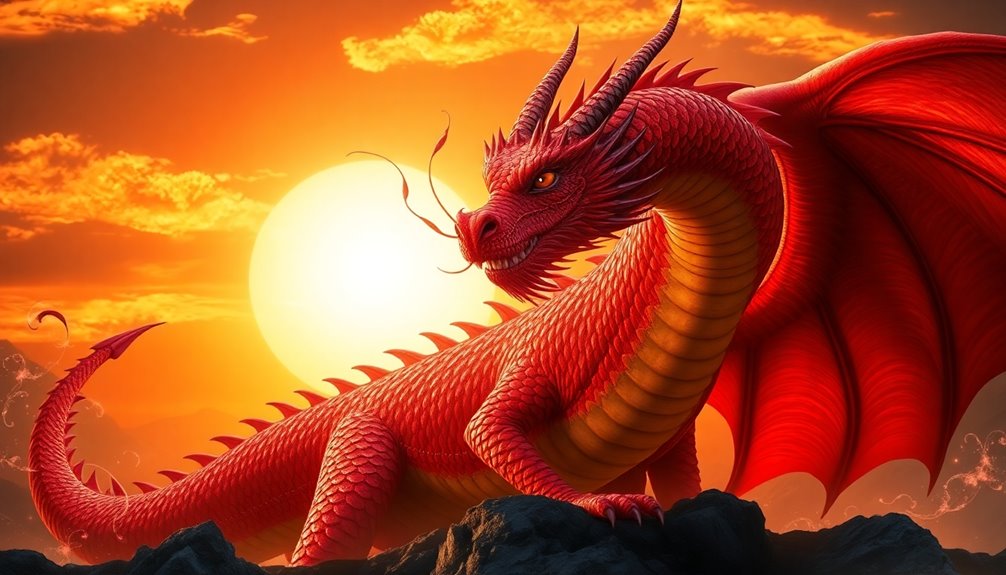
Harnessing their elemental powers, dragons possess a wide array of magical abilities that set them apart in the realm of fantasy. Each dragon embodies an element determined at conception, like Fire or Ice, which they master throughout their lives. As they grow, their mastery evolves through various levels, from intermediate spells to complex magics, allowing them to wield power with increasing control. You'll find that a Class Four dragon can perform intermediate magics, while a Class Nine dragon can create new spells entirely. Specific abilities vary by element; for instance, a Fire dragon can unleash a devastating Light Blast, while an Earth dragon might conjure Rock Defense for protection. Additionally, dragons often draw upon their magical prowess to enhance their elemental abilities, further distinguishing them in the magical hierarchy. Montessori toys can similarly encourage hands-on learning and exploration, providing children with opportunities to develop their own creative powers and problem-solving skills through imaginative play.
Red dragons, in particular, have the unique ability to transform into humans, blending into societies to influence events and accumulate power discreetly. Their magical prowess extends to crafting relics and controlling fire, making them formidable in both combat and strategy. Advanced dragons can even utilize portal magic, connecting realms in ways that amplify their already impressive abilities. This rich tapestry of magical skills defines the essence of dragons, granting them a mystique that captivates the imagination. Furthermore, some dragons can tap into the ability of Invincibility, providing them a temporary edge in battles against formidable foes. The concept of social skills can also be explored through collaborative play, fostering relationships and understanding among individuals.
Western Mythology Perspectives
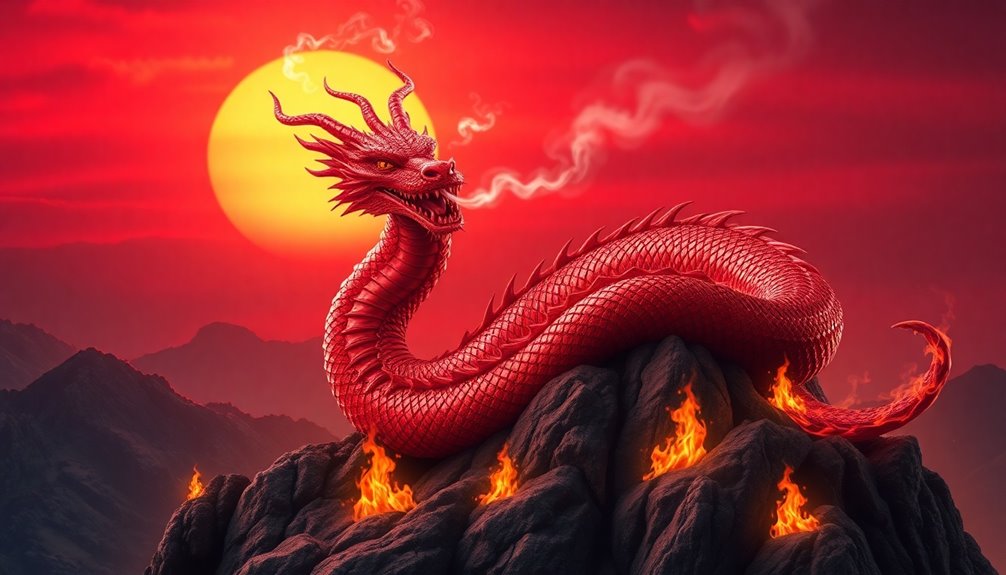
What shapes the perception of dragons in Western mythology? In medieval Europe, dragons often appear as fierce adversaries to knights and heroes, symbolizing bravery and the ultimate test of valor. You might recall tales like that of Saint George, where the dragon represents the chaotic forces that threaten order. These creatures typically breathe fire and hoard treasures, embodying chaos and devastation. Notably, Eastern dragons also symbolize imperial power and prosperity, contrasting sharply with their Western counterparts.
In literature, dragons serve as emblems of unchecked power, driven by greed and the desire to dominate. They can block life-giving forces, representing disorder and anti-hierarchical chaos. This portrayal shifts with the rise of Christianity, where dragons began to symbolize evil, akin to Satan. Additionally, dragons can symbolize the emotional dysregulation that many heroes must confront in their journeys. Their fierce nature and risk-taking behavior reflect the challenges faced by entrepreneurs in their quests for success. The concept of greatest happiness also resonates, as heroes often seek to restore balance and well-being in their battles against these formidable foes. Notably, the lifespan perspective emphasizes how these battles are often reflective of the heroes' continuous growth and development through their experiences.
Celtic mythology adds depth, as red dragons symbolize national identity, while heraldic dragons distinguish different factions in medieval heraldry.
As you explore these tales, you'll notice how dragons evolve from mere beasts to complex characters with personal motives. They guard treasures and challenge heroes, reflecting the cosmic battles between good and evil.
Through various cultures, dragons reveal a rich tapestry of symbolism influenced by historical and moral perspectives.
Spiritual Significance
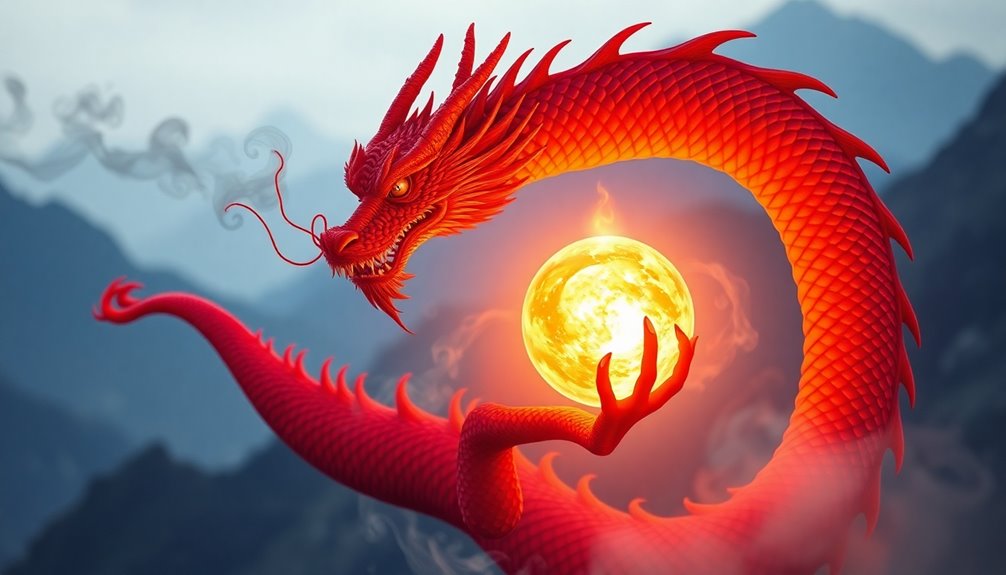
Dragons hold profound spiritual significance across various cultures, often acting as powerful symbols of transformation and duality. In the Biblical context, the red dragon represents faith devoid of love, warning you against beliefs that lead to harm and domination. Its seven heads symbolize insanity stemming from falsified truths, highlighting the destructive nature of such ideas. This serves as a spiritual reminder to keep your faith intertwined with love. The dragon's ten horns signify immense power and authority, further illustrating the danger of unchecked beliefs.
Alchemically, the dragon embodies Mercurius, the divine winged Hermes, representing both creative and destructive forces. It reflects the unity of opposites, guarding your inner riches while encouraging cyclic transformation, much like the Uroboros.
In Celtic traditions, dragons symbolize balance among the four elements and represent wisdom and transformation. The earth dragon invites you to explore your depths, while the water dragon embodies compassion and reflection. The fire dragon fuels your passion and vitality.
As a power animal, the dragon signifies purification, renewal, and protection. It empowers you to face challenges with ambition and strength, reminding you of the importance of personal growth and the wisdom that comes from overcoming adversity.
Cultural Impact
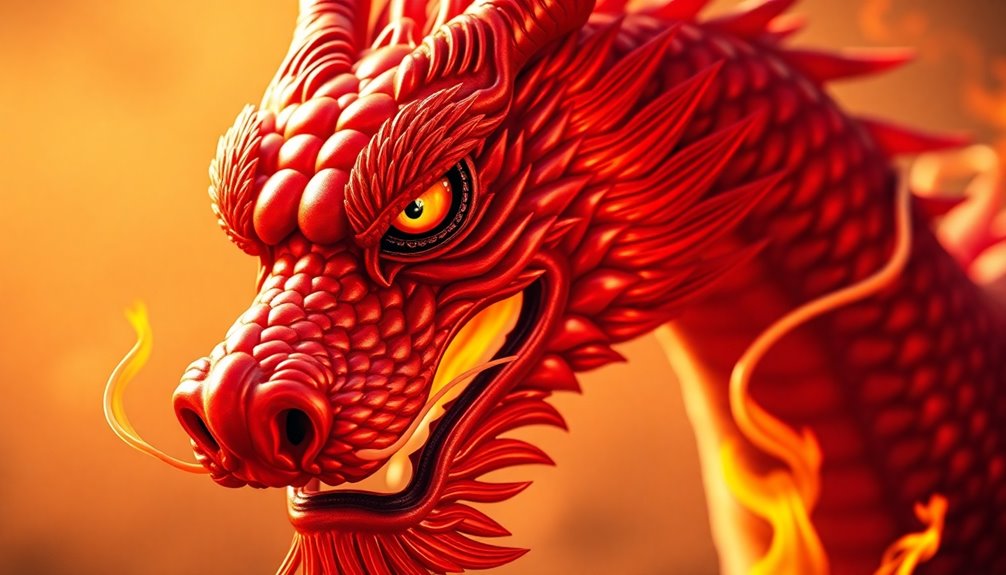
Throughout history, the red dragon has significantly influenced various cultures, especially in Asia. In Chinese culture, it symbolizes power and authority, closely associated with emperors and the imperial throne. Only members of the imperial family could wear dragon motifs, emphasizing its exclusivity. This majestic creature represents good luck, strength, and health, and its significance has remained consistent over centuries. Additionally, AI technologies have been increasingly utilized in educational programs to enhance the learning experience regarding cultural symbols like the red dragon. The impact of the red dragon is also reflected in its role in Bollywood legends who often incorporate such symbols in their storytelling, promoting cultural narratives through film. Furthermore, the red dragon's prominence in festivals can be likened to the way solar energy is celebrated for its benefits in contemporary society.
The dragon also fosters unity across Asia. Celebrations like the Year of the Dragon are shared among countries such as Korea, Vietnam, and Malaysia, creating a sense of shared heritage. These festivities help preserve cultural identities through traditional practices and rituals, while the dragon itself symbolizes good fortune and the essential elements like rain. In fact, the Year of the Dragon occurs every 12 years, with the next occurrence in 2024, further enhancing its significance in cultural celebrations. Additionally, the celebration of the Year of the Dragon often includes major festivals that attract tourists and promote cultural exchange.
In contrast, Western cultures often depict dragons negatively, associating them with chaos and evil, largely due to early Christian influences. This divergence highlights the different cultural interpretations of the dragon's symbolism.
Despite these differences, the red dragon's modern relevance is undeniable. It serves as a political symbol and a source of cultural pride, reflecting unity and prosperity for Chinese communities worldwide. This enduring impact makes the red dragon a powerful emblem in both historical and contemporary contexts.
The Dragon and the Phoenix
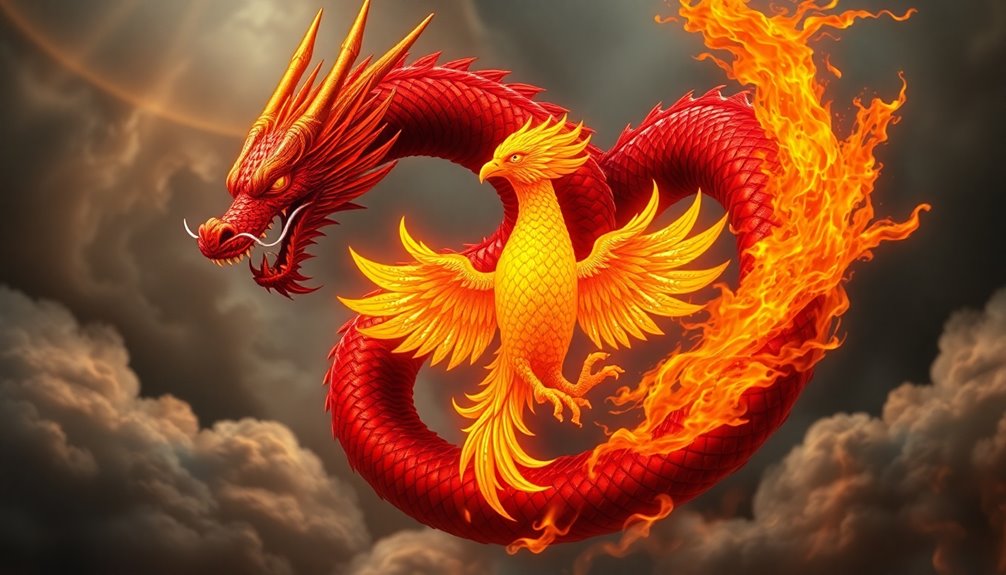
In many cultures, the dragon and the phoenix are celebrated as profound symbols of balance and harmony. The dragon represents the masculine force, embodying strength, power, and the element of water, while the phoenix symbolizes the feminine, showcasing grace, beauty, and the element of fire. Together, they illustrate the harmonious union of opposites, reflecting the balance of yin and yang. Aromatherapy practices can also enhance this sense of balance by promoting relaxation and well-being. Additionally, the importance of interactive learning toys in early childhood development mirrors this balance by fostering cognitive and social skills. Engaging with enrichment toys can significantly enhance a child's sensory exploration and cognitive growth.
In Chinese mythology, dragons are revered for their supernatural abilities and are often linked with weather and water control. Conversely, phoenixes are seen as symbols of transformation and resurrection, embodying good fortune and prosperity. Their eternal dance signifies perfect balance and is frequently invoked during weddings to represent a harmonious and prosperous union. During these ceremonies, the exchange of Dragon and Phoenix bangles invokes blessings for enduring love and unity.
In Feng Shui, the dragon and phoenix are the ideal couple, symbolizing marital happiness and success. The dragon's male vigor complements the phoenix's female beauty, ensuring a fruitful marriage blessed with love and endurance. The principles of aromatherapy techniques can further enhance marital harmony by creating a soothing environment.
These mythical beings represent the interconnectedness of masculine and feminine forces, acting as guardians of cosmic balance and ensuring harmony in both material and spiritual realms.
Transformation and Renewal
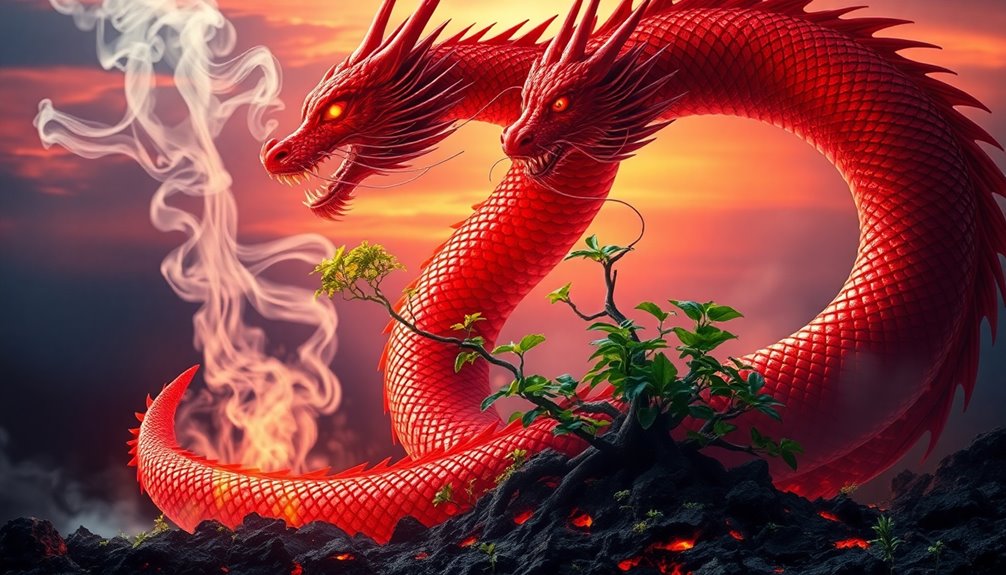
The interplay between the dragon and phoenix not only symbolizes harmony but also sets the stage for understanding transformation and renewal in mythology. In many cultures, dragons represent the profound cycles of life, reflecting both the nurturing and destructive aspects of nature. Artists often explore these themes through urban imagery, showcasing the duality of growth and decay in their works. Relationships often mirror this duality, as both uplifting and challenging experiences contribute to personal growth. Many individuals find that attending spiritual retreats can enhance their journey of transformation.
You'll find that dragons are often linked to water, symbolizing purification and regeneration. Just as rain nourishes the earth, the dragon embodies the essence of renewal. The cyclical nature of life is emphasized by the dragon's role in representing the phoenix's rebirth as it emerges from ashes. Additionally, engaging with music therapy can enhance emotional well-being during times of transformation.
In various legends, transformation is a recurring theme. For instance, the tale of a boy turning into a dragon illustrates personal metamorphosis, where humility transforms into guardianship and strength. This narrative resonates deeply, highlighting the journey towards self-mastery.
Moreover, dragons symbolize the rhythms of nature, accentuating the seasonal cycles of growth and decline. The concept of eternal renewal is beautifully captured in the ouroboros, a dragon devouring its own tail, signifying infinite transformation. The vibrant colors and intricate designs of traditional art forms, like Patua scrolls, also convey stories of renewal and cultural continuity.
Ultimately, dragons serve as powerful metaphors for change. They remind you that through struggle and adversity, renewal and growth aren't only possible but essential aspects of life's journey. Understanding the importance of self-reflection can further enhance the transformative process.
Emblem of Power
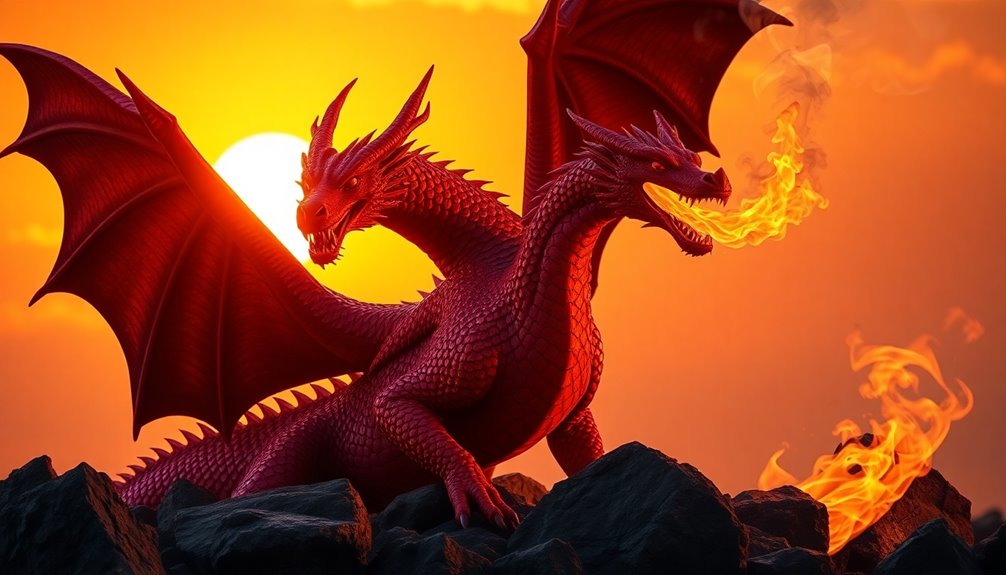
Dragons stand as potent emblems of power across various cultures, embodying authority and strength in ways that resonate deeply with human experience. In Chinese culture, they symbolize imperial power, representing the emperor's authority with their yang energy. This powerful creature is also associated with weather, bringing vital rain for agriculture, showcasing its importance in sustaining life. You might recognize the term "Descendants of the Dragon," which signifies a person's reputation and strength.
Globally, dragons appear in mythologies, often embodying high spiritual power and the supernatural. They represent both the creative and destructive forces of nature, acting as guardians of treasures and masters of the ground. In spiritual contexts, dragons symbolize courage, igniting your inner strength and creativity. Additionally, the Chinese Dragon represents the cyclical nature of life and personal mastery, emphasizing transformation and renewal.
You'll find that in Celtic culture, dragons signify protection, transformation, and power. They connect with the earthy powers of kings and emperors, representing wholeness by combining yin and yang energies.
Celebrations and Traditions

Celebrations and traditions surrounding the red dragon showcase its significance in cultural events, particularly in Chinese New Year festivities. You'll see red dragons adorning homes and walkways, symbolizing good fortune and joy. As families reunite, the atmosphere buzzes with excitement, with loved ones traveling from afar to celebrate together.
Fireworks and firecrackers fill the air, warding off evil spirits and ensuring a fresh start. One of the highlights is the vibrant dragon dance, performed to the rhythmic beat of drums and clashing cymbals. This captivating display chases away negativity while welcoming good luck. During this time, the celebration emphasizes family reunions, reflecting the importance of familial bonds in Chinese culture.
Meanwhile, the giving of red envelopes, or hongbao, is a cherished tradition, symbolizing blessings and well-wishes shared among family and friends. As you prepare traditional foods like dumplings and sticky rice cake (nian gao), each dish carries significant meanings of wealth and abundance.
Cleaning your home before the New Year helps sweep away bad luck, while red decorations, including lanterns and paper cutouts, invite happiness into your life. Engaging in these customs connects you to the rich tapestry of cultural heritage and the enduring power of the red dragon.
Frequently Asked Questions
What Colors Represent Different Types of Dragons in Various Cultures?
Different colors represent various types of dragons across cultures.
For instance, red dragons symbolize energy and courage, while green dragons epitomize healing and growth.
Black dragons often signify protection and power, whereas gold dragons embody wisdom and prosperity.
Yellow dragons are linked to imperial authority, and blue and green dragons represent nature and balance.
White dragons symbolize purity but can also carry ominous meanings.
Each color adds unique significance to dragon lore.
How Do Dragons Influence Modern Art and Literature?
Dragons shape modern art and literature by serving as symbols of power, wisdom, and transformation.
You'll find them in diverse narratives, from fantasy novels to visual arts, reflecting complex themes like identity and societal norms. Their majestic presence inspires creativity, inviting you to explore deep emotional connections between characters.
As you engage with these works, you'll see how dragons challenge perceptions and enrich storytelling, making them vital to contemporary cultural expressions.
Are There Any Famous Historical Figures Associated With Red Dragons?
Yes, several famous historical figures are associated with red dragons.
You might recognize Maelgwn Gwynedd and Mynyddog Mwynfawr, both ancient Celtic leaders personified as dragons in Welsh mythology.
King Cadwaladr of Gwynedd famously carried the red dragon into battle, symbolizing Welsh identity.
Additionally, Owain Glyndŵr led a significant rebellion against English rule, embracing the red dragon as a symbol of resilience.
Each of these figures contributes to the rich tapestry of Welsh history and mythology.
What Are Common Misconceptions About Dragons in Different Cultures?
When exploring dragons across cultures, you might find several misconceptions.
For instance, Eastern dragons aren't fire-breathers; they're often linked to water and prosperity. Conversely, not all Western dragons are evil; some can be neutral or even kind.
Additionally, dragon symbolism isn't universal—what represents power in one culture might signify chaos in another.
You'll discover diverse appearances, too, with Eastern dragons being snake-like while Western dragons often flaunt wings and breathe fire.
How Do Red Dragons Differ From Other Mythical Creatures?
When you think about red dragons, you notice they stand apart from other mythical creatures.
They're aggressive and territorial, thriving in desolate, fiery habitats like mountains and volcanic caverns. Unlike benevolent Chinese and Welsh dragons, red dragons embody chaos and destruction, driven by power and dominance.
Their innate magical abilities, particularly with fire, further distinguish them. While other dragons symbolize luck or protection, red dragons often represent formidable adversaries in folklore.
Conclusion
In exploring the red dragon's symbolism, you've uncovered its deep roots in various cultures and mythologies. This fiery emblem embodies power, transformation, and renewal, making it a potent symbol in both Eastern and Western traditions. As you celebrate its significance, remember the dragon's role in your life—representing strength and the potential for change. Embrace its magical essence, and let it inspire you to harness your own power and transform challenges into opportunities for growth.

